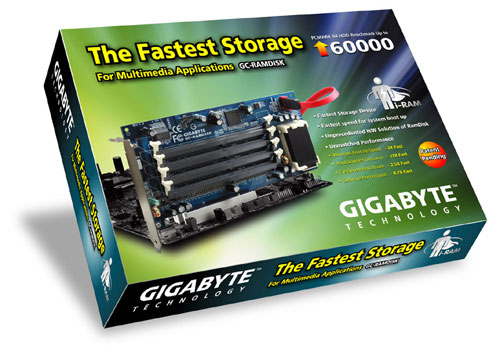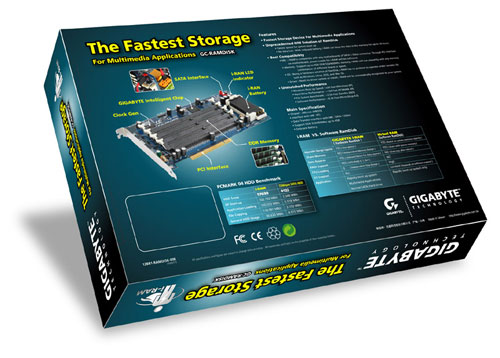Gigabyte's i-RAM: Affordable Solid State Storage
by Anand Lal Shimpi on July 25, 2005 3:50 PM EST- Posted in
- Storage
For years now, motherboard manufacturers have been struggling to find other markets to branch out to, in an attempt to diversify themselves, preparing for inevitable consolidation in the market. Every year at Computex, we'd hear more and more about how the motherboard business was getting tougher and we'd see more and more non-motherboard products from these manufacturers. For the most part, the non-motherboard products weren't anything special. Everyone went into making servers, then multimedia products, then cases, networking, security, water cooling; the list goes on and on.
This year's Computex wasn't very different, except for one thing. When Gigabyte showed us their collection of goodies for the new year, we were actually quite interested in one of them. And after we posted an article about it, we found that quite a few of you were very interested in it too. Gigabyte's i-RAM was an immediate success and it wasn't so much that the product was a success, but it was the idea that piqued everyone's interests.
Pretty much every time a faster CPU is released, we always hear from a group of users who are marveled by the rate at which CPUs get faster, but loathe the sluggish rate that storage evolves. We've been stuck with hard disks for decades now, and although the thought of eventually migrating to solid state storage has always been there, it's always been so very distant. These days, you can easily get a multi-gigabyte solid state drive if you're willing to spend the tens of thousands of dollars it costs to get one; prices actually vary from the low $1000s to the $100K range for solid state devices, obviously making them impractical for desktop users.
The performance benefits of solid state storage have always been tempting. With no moving parts, reliability is improved tremendously, and at the same time, random accesses are no longer limited by slow and difficult to position read/write heads. While sequential transfer rates have improved tremendously over the past 5 years, thanks to ever increasing platter densities among other improvements, it is the incredibly high latency that makes random accesses very expensive from a performance standpoint for conventional hard disks. A huge reduction in random access latency and increase in peak bandwidth are clear performance advantages to solid state storage, but until now, they both came at a very high price.
The other issue with solid state storage is that DRAM is volatile, meaning that as soon as power is removed from the drive, all of your data would be lost. More expensive solutions get around this by using a combination of a battery backup as well as a hard disk that keeps a backup of all data written to the solid state drive, just in case the battery or main power should fail.
Recognizing the allure of solid state storage, especially to performance-conscious enthusiast users, Gigabyte went about creating the first affordable solid state storage device, and they called it i-RAM.
Through some custom logic, the i-RAM works and acts just like a regular SATA hard drive. But how much of a performance increase is there for desktop users? And is the i-RAM worth its still fairly high cost of entry? We've spent the past week trying to find out...
This year's Computex wasn't very different, except for one thing. When Gigabyte showed us their collection of goodies for the new year, we were actually quite interested in one of them. And after we posted an article about it, we found that quite a few of you were very interested in it too. Gigabyte's i-RAM was an immediate success and it wasn't so much that the product was a success, but it was the idea that piqued everyone's interests.
Pretty much every time a faster CPU is released, we always hear from a group of users who are marveled by the rate at which CPUs get faster, but loathe the sluggish rate that storage evolves. We've been stuck with hard disks for decades now, and although the thought of eventually migrating to solid state storage has always been there, it's always been so very distant. These days, you can easily get a multi-gigabyte solid state drive if you're willing to spend the tens of thousands of dollars it costs to get one; prices actually vary from the low $1000s to the $100K range for solid state devices, obviously making them impractical for desktop users.
The performance benefits of solid state storage have always been tempting. With no moving parts, reliability is improved tremendously, and at the same time, random accesses are no longer limited by slow and difficult to position read/write heads. While sequential transfer rates have improved tremendously over the past 5 years, thanks to ever increasing platter densities among other improvements, it is the incredibly high latency that makes random accesses very expensive from a performance standpoint for conventional hard disks. A huge reduction in random access latency and increase in peak bandwidth are clear performance advantages to solid state storage, but until now, they both came at a very high price.
The other issue with solid state storage is that DRAM is volatile, meaning that as soon as power is removed from the drive, all of your data would be lost. More expensive solutions get around this by using a combination of a battery backup as well as a hard disk that keeps a backup of all data written to the solid state drive, just in case the battery or main power should fail.
Recognizing the allure of solid state storage, especially to performance-conscious enthusiast users, Gigabyte went about creating the first affordable solid state storage device, and they called it i-RAM.



Through some custom logic, the i-RAM works and acts just like a regular SATA hard drive. But how much of a performance increase is there for desktop users? And is the i-RAM worth its still fairly high cost of entry? We've spent the past week trying to find out...










133 Comments
View All Comments
mattsaccount - Monday, July 25, 2005 - link
This thing would still be useful as a pagefile in some circumstances--if all your memory slots were full and/or you had extra memory lying around. This is what I had been planning to do with it (currently have 4x512mb, plus a couple other smaller capacity DDR sticks which would be nice to use b/c for photoshop stuff). But the price is too high. I'll wait till it drops.Son of a N00b - Monday, July 25, 2005 - link
I would love to get two of them and run them in RAID-5 possibly...that way you also have a back up...Gatak - Monday, July 25, 2005 - link
You'd need minimum 3 cards/disks for RAID-5.However, using this card as a journaling device for a normal filesystem, like ReiserFS or Reiser4 might be very beneficial. Wouldn't require much RAM either.
ukDave - Monday, July 25, 2005 - link
Extra things that could have been covered were:Would there be a difference with other SATA cards, such as 3Ware etc - i.e. would CPU usage make a difference perhaps?
Why not use SATA-IO (SATA-2) instead of the older and slower SATA (re: Gigabyte)?
But otherwise a very informative article, thanks Anand.
ss284 - Monday, July 25, 2005 - link
It would be best to wait for the second version of the card, which will hopefully have a cheaper IC as well as sata II support. Theres no doubt that the ram can do 3.0gb/s.Imagine what 2 of these in raid 0 would be like.
-Steve
SDA - Monday, July 25, 2005 - link
- File copy performance is mostly a moot point, because copying files from disk to disk will go as fast as the slower of the two can, and other applications that typically require disk performance (unarchiving et al) will only see a minimal performance increase due to bottlenecks in other parts of the system (which becomes even less valuable when you consider that you won't be doing a whole lot of unarchiving to a disk that small).- Gaming benefit would be okay if it you could fit more than about one modern game on it.
- Using it as a pagefile is, as Anand noted, pointless.
- It does improve boot times, but it's not a huge difference, how many of us shut down often enough to actually be bothered by a few seconds in boot?
- It does improve app loading times slightly, but if you're opening and closing apps that take a lot to open and close, it's probably because you don't have enough system memory, so buy more memory instead.
So basically: whoopee.
DerekWilson - Wednesday, July 27, 2005 - link
I'm just gonna pick at a single point ... you could install one game to the i-ram at a time and then archive them on another drive.You get fast zip times on i-ram and a single file transfer to a magnetic disk is faster than multiple small files (moving the the archive won't take long). Just unzip the game you want to play to i-ram ...
but then ... that kinda defeats the purpose doesn't it ...
I could see this being fun to play with, but I have to agree with Anand -- it needs higher capacity before it is really useful.
Plus, I'd like to see SATA-II :-)
miketheidiot - Monday, July 25, 2005 - link
I don't really see anyone using this, its costs way too much for too little storage and too little performance benefit, not to mention the risk of data loss. I'll give it a look again when they get some higher bandwidth flash or something like that. this i can pass on for now.Sea Shadow - Monday, July 25, 2005 - link
I dunno, I could see the extreme enthusiasts getting these. I mean after all, if they have the money to buy a system with SLI 7800 GTX and FX 57 this would be pocket change.BoberFett - Monday, July 25, 2005 - link
I'd imagine that in some areas the CPU is still the bottleneck and for others the 150MB/sec limit of SATA may be.